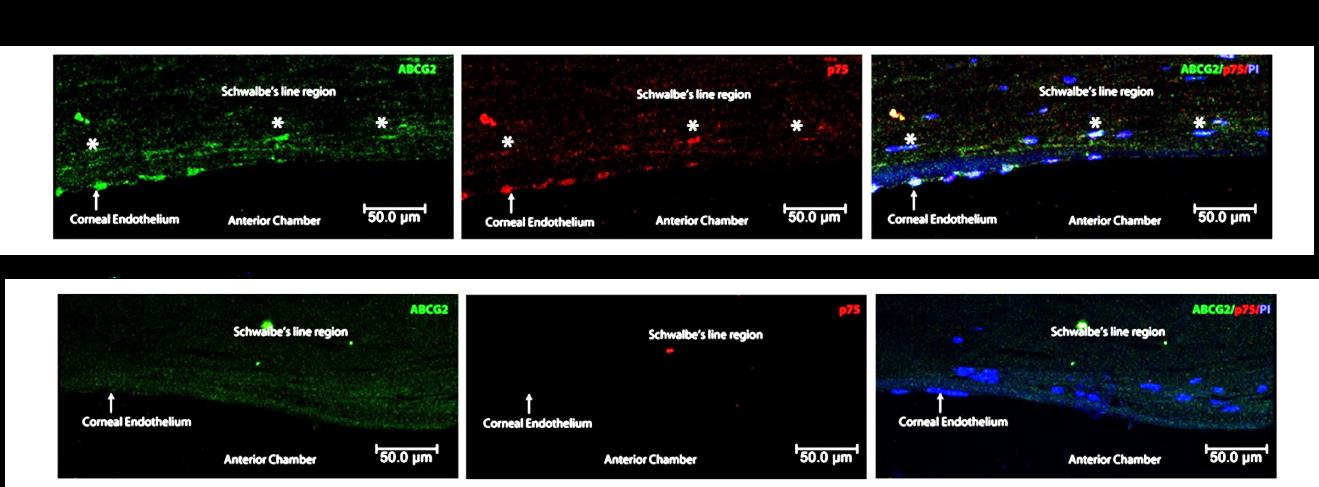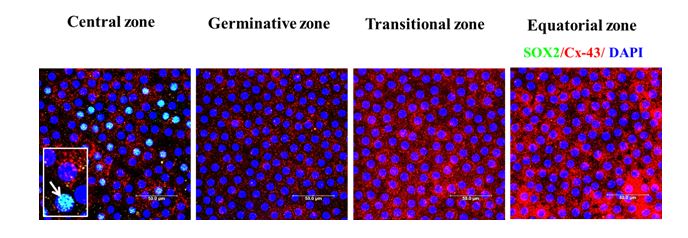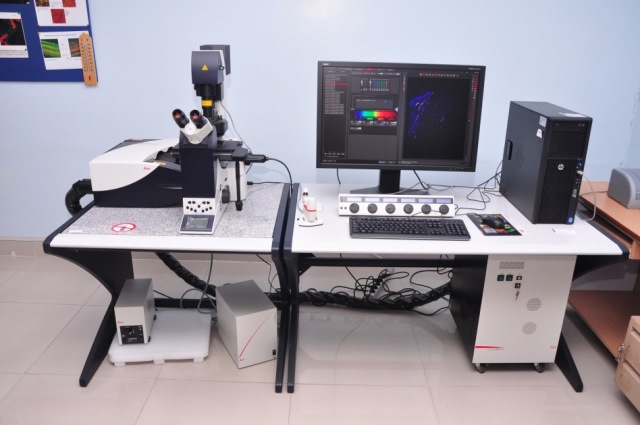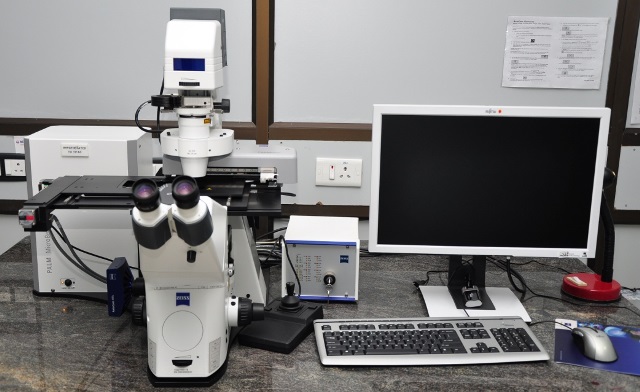The focus of research is to understand the basic biology of adult tissue resident stem cells in the human eye – identification, role in the maintenance of tissue homeostasis, their status with ageing and in diseased condition. This basic research is significant for the development of better stem cell based therapies at an affordable cost. The current aim of the department is to establish a Centre for Adult Ocular Stem Cells. Studies on the limbal epithelial stem cells are being carried out from early 2000 and recently research on other stem cells of the human eye – trabecular meshwork, corneal endothelium, lens epithelium and retinal pigment epithelium have been initiated.
In addition, immunological studies have been carried out to understand the aetiopathogenesis of leptospiral uveitis, parasitic granulomatous uveitis and immune surveillance of congenital rubella syndrome.
These projects are funded by the Government funding agencies – DBT, DRDO, ICMR and SERB as well as Aurolab.
Extensive studies on limbal epithelial stem cells (LESCs) that maintain the corneal epithelium has led to the (i) development of a specific method for the identification and quantification of LESCs by combining high expression of p63/ABCG2 with high nucleus to cytoplasmic ratio, (ii) transplantation of cultured autologous limbal and buccal mucosal epithelial stem cells for corneal surface reconstruction in patients with limbal stem cell deficiency with 25 and 33% success respectively, (iii) identification of limbal stromal niche cells located subjacent to the limbal basal epithelium and demonstration by in vitro studies the importance of these stromal stem cells in maintaining the epithelial stem cells, (iv) establishment of a non-invasive live imaging method – in vivo confocal microscopy, for analyzing the limbal stromal niche cells in healthy individuals, (iv) demonstration that these stromal stem cells are lost in limbal stem cell deficient patients indicating the need to transplant the stromal niche cells along with epithelial stem cells and (v) establishment of a two-step protocol by which the LESCs were enriched from 3-5% in native condition to 80%. The current focus of research is on miRNAs regulating LESCs and their role in the maintenance of stemness.
miRNAs regulating limbal epithelial stem cells

Small RNA sequencing was carried out using the enriched LESCs obtained from donor tissues in comparison to the differentiated central corneal epithelial cells. Hsa-miR-21-5p, hsa-miR-3168, hsa-miR-143-3p, hsa-miR-10a-5p, hsa-miR-150-5p and hsa-miR-1910-5p were identified to be highly expressed in the enriched LESCs population, which was further confirmed by LNA in-situ hybridization and real time PCR analysis. Transfection of cultured limbal epithelial cells revealed that higher expression of hsa-miR-143-3p and hsa-miR-150-5p increased the stem cell content in culture based on colony forming efficiency with the ability to form holoclones, an increased expression of ABCG2, Nanog, Oct4, Klf4 and ΔNp63 but a reduced expression of corneal differentiation marker – connexin 43. In this mimics treated group, Wnt signaling was found to be down regulated which was further confirmed by the down regulation of β catenin and Axin2 along with the upregulation of TCF3 gene which is a known inhibitor of Wnt signaling.
Loss of Trabecular Meshwork Stem Cells in Primary Open Angle Glaucoma

The stem cell content in human trabecular meshwork (TM) was identified and quantified on the basis of two parameter analysis- high expression of ABCG2 and high nucleus to cytoplasmic ratio which was established for limbal epithelial and buccal mucosal epithelial cells. This was confirmed to be specific for trabecular meshwork stem cells (TMSCs) based on the co-expression of either putative stem cell markers- p75and AnkG; and their slow cycling property- BrdU label retaining cell property. Analysis of native TM both in isolated cells and in sections in different age group (<30 years; 30-60 year; >60 years, n=5 each) indicated a significant age-related reduction in TMSCs which correlated with TM cell loss with ageing. Further the loss of total TM cells was significantly higher in glaucomatous donor eyes compared to age matched controls and a reduction was also observed in TMSC content. These results strongly indicated a role for TMSCs in glaucoma pathogenesis. Further studies are being carried out to develop a adult stem cell based therapy for glaucoma using human organ culture of the anterior segment (HOCAS).
Identification of human lens epithelial stem cells

The presence of stem cells in the human anterior lens epithelium has been identified on the basis of SOX2 positive and connexin-43(Cx-43) negative cells in the central zone of the whole mount of human anterior lens epithelium. These cells were positive for α-crystallin but negative for β and γ crystallin. Except for the central zone, the cells in the other zones of the anterior lens epithelium were negative for SOX2. The periphery to the central zone is the germinative zone which was demarcated on the basis of Cx-43 positivity (Cx-43+, β crystallin–, γ crystallin–), transition zone by the expression of β crystallin (Cx-43+, β crystallin+, γ crystallin–) and the equatorial zone by γ crystallin (Cx-43+, β crystallin+, γ crystallin+). Further studies are being carried out to elucidate the functional role of the lens epithelial stem cells in the maintenance of tissue homeostasis with ageing and their status in the age related cataract.
Translational Research
In addition, projects of clinical significance carried out in this department are:
- Evaluation of the efficacy of the corneal storage medium – Cornisol
- Effect of VEGF level in tenon’s fibroblasts on the outcome of glaucoma surgery
- Evaluation of surface free energy of the glaucoma drainage implant – AADI and
- Mechanism of understanding posterior capsular opacification (PCO)
Ongoing Projects
- Characterization and Functional Evaluation of Trabecular Meshwork Stem Cells in Glaucoma Pathogenesis. Funding agency: Scientific and Engineering Research Board (2018-2020)
- Characterization of adult human lens epithelial stem cells in the maintenance of tissue homeostasis throughout life and their functional status in cataractous lens. Funding agency: Science and Engineering Research Board (SERB)(2019-2022)
Faculty
Clinician Scientist
- Dr. Venkatesh Prajna
- Dr. S.R. Krishnadas
- Dr. Haripriya Aravind
- Dr. Madhu Shekhar
- Dr. R. Kim
- Dr. K. Naresh Babu
Research Scholars
- Ms. S. Yogapriya
- Mrs. K. Lavanya
- Ms. P. Saranya
- Mrs. R. Iswarya
- Mrs. A. Waseema
- Ms. A.P. Swetha
Lab Assistants:
- Mrs. P. Vigneswari
Model: TCS SP8
Manufacturer: Leica, Wetzlar, Germany
Leica TCS SP8 confocal laser scanning microscope is an inverted microscope designed for optical imaging with optimal photon efficiency and high speed; facilitating optical sectioning. This microscope is equipped with 4 laser ports namely UV/405, laser blue 488nm, laser green 552nm and laser red 638nm.




